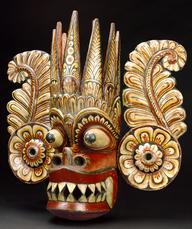


Wooden netsuke, depicting a man with a moxa on his leg, from the Nagoya school, signed Tametaka, Japanese, 1771-1800
Netsuke are toggle-like ornaments. They hang objects such as medicine boxes or tobacco pouches from the sash of a kimono. A kimono is a traditional form of Japanese dress. This netsuke is signed ‘Tametaka’. It shows an old man undergoing a traditional treatment called moxibustion on his leg. This involves burning dried moxa, a plant known as Artemisia vulgaris, which is then held close to the skin. Traditional Chinese Medicine believes moxibustion stimulates the flow of the life force known as qi (chi) around the body. Qi is considered essential for wellbeing and health.
Details
- Category:
- Asian Medicine
- Collection:
- Sir Henry Wellcome's Museum Collection
- Object Number:
- A642979
- Materials:
- complete and wood (unidentified)
- Measurements:
-
overall: 46 mm x 27.4 mm x 35.5 mm,
- type:
- netsuke
- credit:
- Glendining




